|
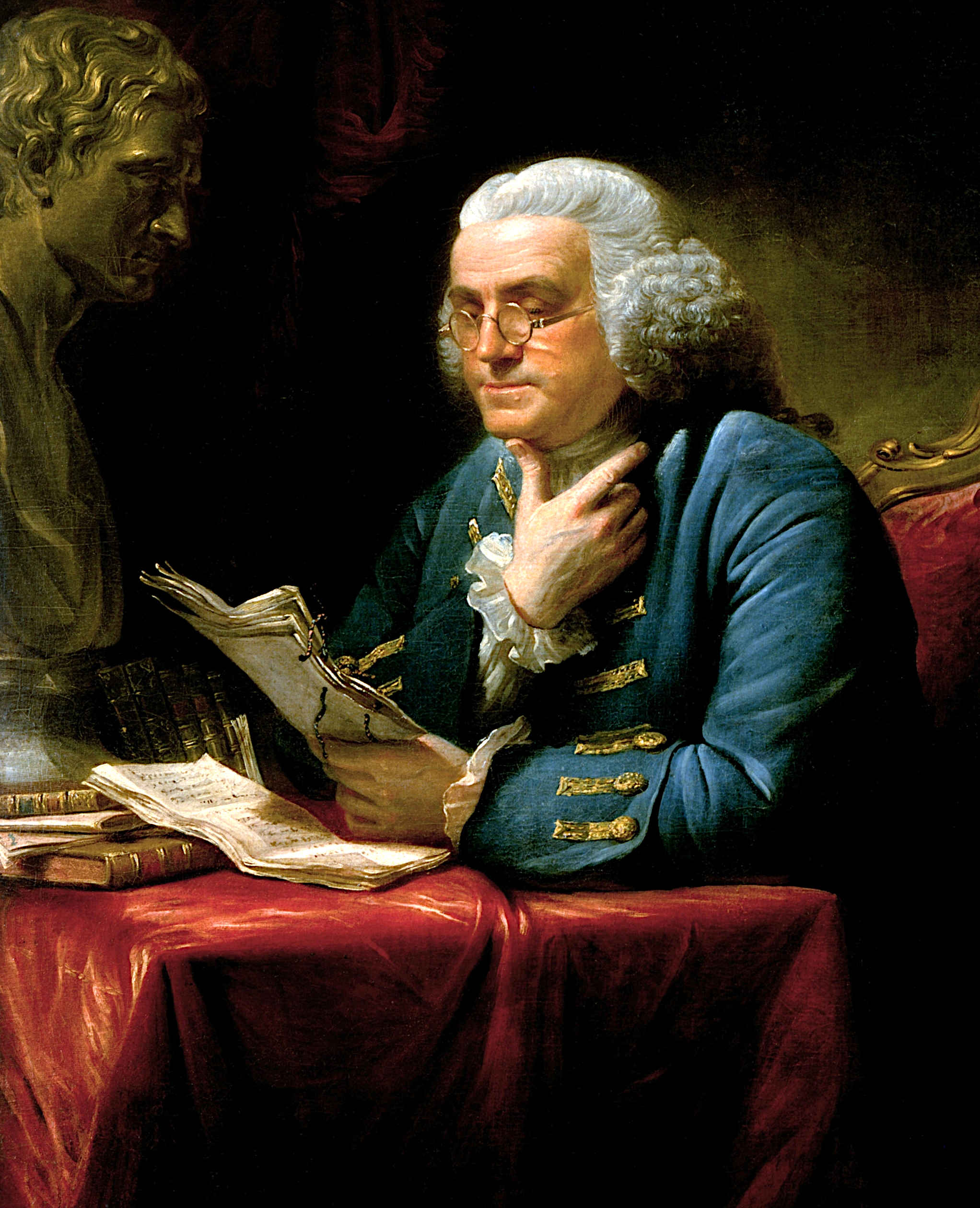
Benjamin
Franklin was one of the founding fathers, passionate about the independence
of America from British tyrany.
It is widely reported that as a 12-year-old, Benjamin Franklin penned the first poem featuring the notorious freebooter
Edward Teach, alias Blackbeard, whose silver-plated skull was a stellar attraction of a superbly mounted, pirate-oriented exhibition at the Mariners' Museum in Newport News from 30th August to 4th Jauary 1998 - complete with Jolly Roger.
Calling on episodes and characters `Under the Black Flag: the Romance and the Reality of Life Among the Pirates'' for its themes, the 1998 exhibition was held to be so convincing you could almost hear a fiendishly resounding ``Yo heave ho and a bottle of rum'' resound through the galleries at any moment while you are examining the objects on display.
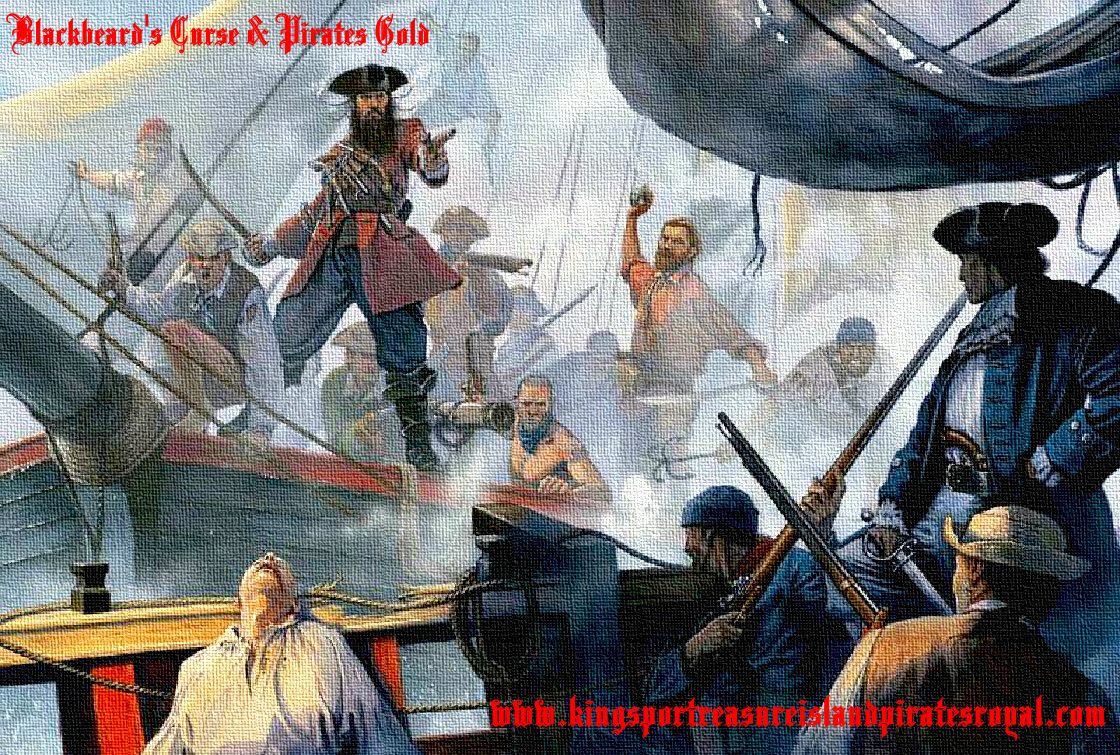
Lieutenant
Robert Maynard rams the Adventure with his Royal Navy sloop. Then boards
Blackbeard's ship. Franklin wrote a ballad titled The Downfall of Piracy" when he was
near 13. That was in 1719, the year after British officer Robert Maynard killed Edward Teach (Blackbeard) in a bloody battle near Ocracoke. The ballad (in very awkward rhyme scheme) described the last hours of Blackbeard's life. In later years, Franklin himself would label it as "wretched stuff", but readers can decide for themselves.
Returning to Franklin's poem, every Tidewater history buff knows that Royal Navy Lt. Robert Maynard put a period to Blackbeard's nefarious career at Ocracoke Inlet, N.C., early in November 1718. Few realize, however, that the event was celebrated shortly thereafter by Franklin, then an apprentice of his brother, James, a printer, in Boston. Taking advantage of the sensational news that arrived there shortly after Blackbeard's death, young Benjamin wrote the following ballad, set it up in type, printed it as a broadside, and hawked it through the streets of Boston. Titled ``The Downfall of Piracy,'' Franklin's juvenile doggerel chronicled Blackbeard's last days as follows:
``Will you hear of a bloody Battle, lately fought upon the Seas?
``It will make your Ears to rattle, and our Admiration cease:
``Have you heard of Teach the Rover, and his Knavery on the Main;
``How of Gold he was a Lover, how he lov'd all ill-got Gain?
``When the Act of Grace apeared, Captain Teach, with all his Men,
``Unto Carolina steered, where they kindly us'd him then;
``There he marry'd to a lady, and gave her five hundred Pound,
``But to her he prov'd unsteady, for he soon march'd off the Ground.
``And returned, as I tell you, to his Robbery as before,
``Burning, sinking Ships of value, filling them with Purple Gore;
``When he was at Carolina, there the Governor did send
``To the Governor of Virginia, that he might assistance lend.
``Then the Man-of-War's Commander, two small Sloops he fitted out,
``Fifty Men he put on board, Sir, who resolved to stand it out:
``The Lieutenant he commanded both the Sloops, and you shall hear
``How, before he landed, he suppress'd them without fear.
``Valliant Maynard as he sailed, soon the Pirate did espy,
``With his Trumpet he then hailed, and to him they did reply:
``Captain Teach is our Commander, Maynard said, he is the Man
``Whom I am resolv'd to hang, Sir, let him do the best he can.
``Teach replyed unto Maynard, you no Quarter here shall see,
``But be hang'd on the Mainyard, you and all your Company;
``Maynard said, I none desire of such Knaves as thee and thine,
``None I'll give, Teach then replyed, My Boys, give me a Glass of Wine.
``He took the Glass, and drank Damnation, unto Maynard and his Crew:
``To himself and Generation, then the Glass away he threw:
``Brave Maynard was resolv'd to have him, tho' he'd Cannons nine or ten;
``Teach a broadside quickly gave him, killing sixteen valliant Men.
``Maynard boarded him, and to it they fell with Sword and pistol too;
``They had Courage, and did show it, killing of the Pirate's Crew.
``Teach and Maynard on the Quarter, fought it out most manfully,
``Maynard's Sword did cut him shorter, losing his head, he there did die.
``Every Sailor fought while he, Sir, power had to wield the Sword,
``Not a Coward could you see, Sir, fear was driven from aboard;
``Wounded Men on both Sides fell, Sir, 't was a doleful Sight to see,
``Nothing could their Courage quell, Sir, O, they fought courageously.
``When the bloody fight was over, we're informed by a Letter writ,
``Teach's Head was made a Cover, to the Jack Staff of the Ship:
``Thus they sailed to Virginia, and when they the Story told,
``How they kill'd the Pirates many, they'd Applause from young and old.''
Not bad for a 12-year-old who later, as the deputy postmaster for the American colonies, visited Norfolk in 1756, at which time he was made an honorary citizen of the borough.
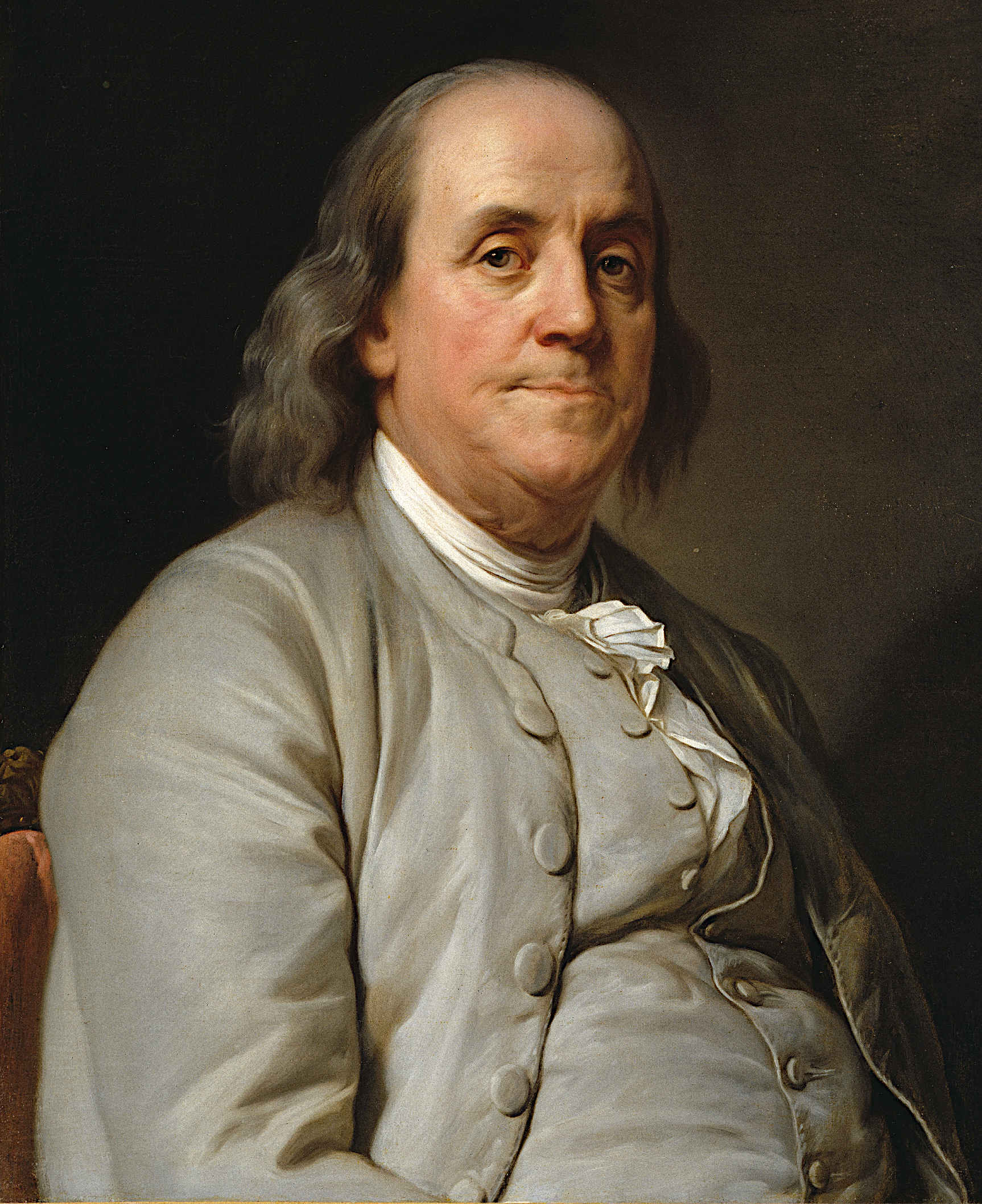
Benjamin
Franklin in 1778
ABOUT
BENJAMIN FRANKLIN
Benjamin Franklin FRS FRSA FRSE (January 17, 1706 – April 17, 1790) was an American polymath who was active as a writer, scientist, inventor, statesman, diplomat, printer, publisher, forger and political philosopher. Among the leading intellectuals of his time, Franklin was one of the Founding Fathers of the United States, a drafter and signer of the Declaration of Independence, and the first Postmaster General.
As a scientist, he was a major figure in the American Enlightenment and the history of physics for his studies of electricity, and for charting and naming the Gulf Stream current. As an inventor, he is known for the lightning rod, bifocals, and the Franklin stove, among others. He founded many civic organizations, including the Library Company, Philadelphia's first fire department, and the University of Pennsylvania. Franklin earned the title of "The First American" for his early and indefatigable campaigning for colonial unity, and as an author and spokesman in London for several colonies. As the first U.S. ambassador to France, he exemplified the emerging American nation. Franklin was foundational in defining the American ethos as a marriage of the practical values of thrift, hard work, education, community spirit, self-governing institutions, and opposition to authoritarianism both political and religious, with the scientific and tolerant values of the Enlightenment. In the words of historian Henry Steele Commager, "In Franklin could be merged the virtues of Puritanism without its defects, the illumination of the Enlightenment without its heat." Franklin has been called "the most accomplished American of his age and the most influential in inventing the type of society America would become."
Franklin became a successful newspaper editor and printer in Philadelphia, the leading city in the colonies, publishing the Pennsylvania Gazette at age 23. He became wealthy publishing this and Poor Richard's Almanack, which he wrote under the pseudonym "Richard Saunders". After 1767, he was associated with the Pennsylvania Chronicle, a newspaper that was known for its revolutionary sentiments and criticisms of the policies of the British Parliament and the Crown.
He pioneered and was the first president of the Academy and College of Philadelphia, which opened in 1751 and later became the University of Pennsylvania. He organized and was the first secretary of the American Philosophical Society and was elected president in 1769. Franklin became a national hero in America as an agent for several colonies when he spearheaded an effort in London to have the Parliament of Great Britain repeal the unpopular Stamp Act. An accomplished diplomat, he was widely admired among the French as American minister to Paris and was a major figure in the development of positive Franco–American relations. His efforts proved vital for the American Revolution in securing French aid.
He was promoted to deputy postmaster-general for the British colonies on August 10, 1753, having been Philadelphia postmaster for many years, and this enabled him to set up the first national communications network. He was active in community affairs and colonial and state politics, as well as national and international affairs. From 1785 to 1788, he served as governor of Pennsylvania. He initially owned and dealt in slaves but, by the late 1750s, he began arguing against slavery, became an abolitionist, and promoted education and the integration of African Americans into U.S. society.
His life and legacy of scientific and political achievement, and his status as one of America's most influential Founding Fathers, have seen Franklin honored more than two centuries after his death on the $100 bill, warships, and the names of many towns, counties, educational institutions, and corporations, as well as numerous cultural references and with a portrait in the Oval Office. Over his lifetime, Franklin wrote or received more than 30,000 letters and other documents, which since the 1950s have been collected in The Papers of
Benjamin
Franklin, published by both the American Philosophical Society and Yale University.

THE
BATTLE OF OCRACOKE - FASCINATED YOUNG BENJAMIN
It began within minutes after the notorious pirate
Blackbeard was killed in
the Battle at Ocracoke on Saturday morning, November 22nd 1718.
As soon as the wounded were attended to and the surviving pirates were placed under guard, the hunt was on, led by Royal Navy
Lieutenant Robert
Maynard. The first place they searched was Blackbeard’s cabin in the roundhouse of his 65-foot-long Jamaica-rigged sloop, Adventure. Surely the world’s best-known and most-feared pirate captain kept a chest of Spanish
gold,
silver and
jewels hidden beneath his bunk, just for his
walkin’ around money.
Rarely mentioned in the many books, articles and other accounts of the famous battle is that Maynard and the other volunteer sailors from the British king’s ships stationed in Virginia were persuaded to accept the potentially deadly assignment of apprehending or killing the North Carolina pirates by the prospect of acquiring pirate treasure. It could be said that the 60 men aboard the two, small, rented sloops under Maynard’s command were little more than pirates themselves.
Two weeks after the smoke cleared from the battle, Maynard and his men were still hoping to find a treasure on Ocracoke Island that would make them all rich. They were disappointed. In addition to casks of sugar, cocoa, indigo dye and a few bales of cotton, only a small amount of what is called gold dust, small nuggets of gold, were recovered from the pirates’ possessions.
Maynard’s stay at Ocracoke may have been when an enduring Blackbeard
myth was born. While nine captive pirates were held in the lower deck of the Adventure while anchored in the yet-to-be-named Teach’s Hole Channel, a guard may have asked them,
so, where did the boss hide his treasure? Funny you should ask, a pirate replied, we posed that question to him just last night.
The published version of the interrogation in a 1724 book, ”A General History of Pirates,” goes like this: “… one of his Men asked him, in Case any thing should happen to him in the Engagement with the Sloops, whether his Wife knew where he had buried his Money? He answered, That no Body but himself and the Devil, knew where it was, and the longest Liver should take it all.”
Among the many dubious aspects of the preceding quote, my research has proven that Blackbeard and his men had no idea on the night before the battle that they were under any threat at all. Having arrived from the inland waters of the colony and anchored alongside Beacon Island 3 miles away from the pirates’ moorings near today’s Springer’s Point, Maynard’s sloops had all the appearances of typical merchant vessels preparing to put to sea.
Nevertheless, ever since, writers and historians have assumed that because the quote was in print – like so many other popular but improbable Blackbeard legends – it must have been true.
At the end of the two weeks at Ocracoke, Maynard sailed Blackbeard’s Adventure across Pamlico Sound and up to Bath, but not with the pirate’s head hanging under the bowsprit as is so often told – it was too valuable, worth a bounty of 100 pounds sterling back in Virginia. In Maynard’s wake, however, has streamed, like the gold of marine phosphorescence, the hopes of the credulous that Blackbeard’s lost treasure might still be found.
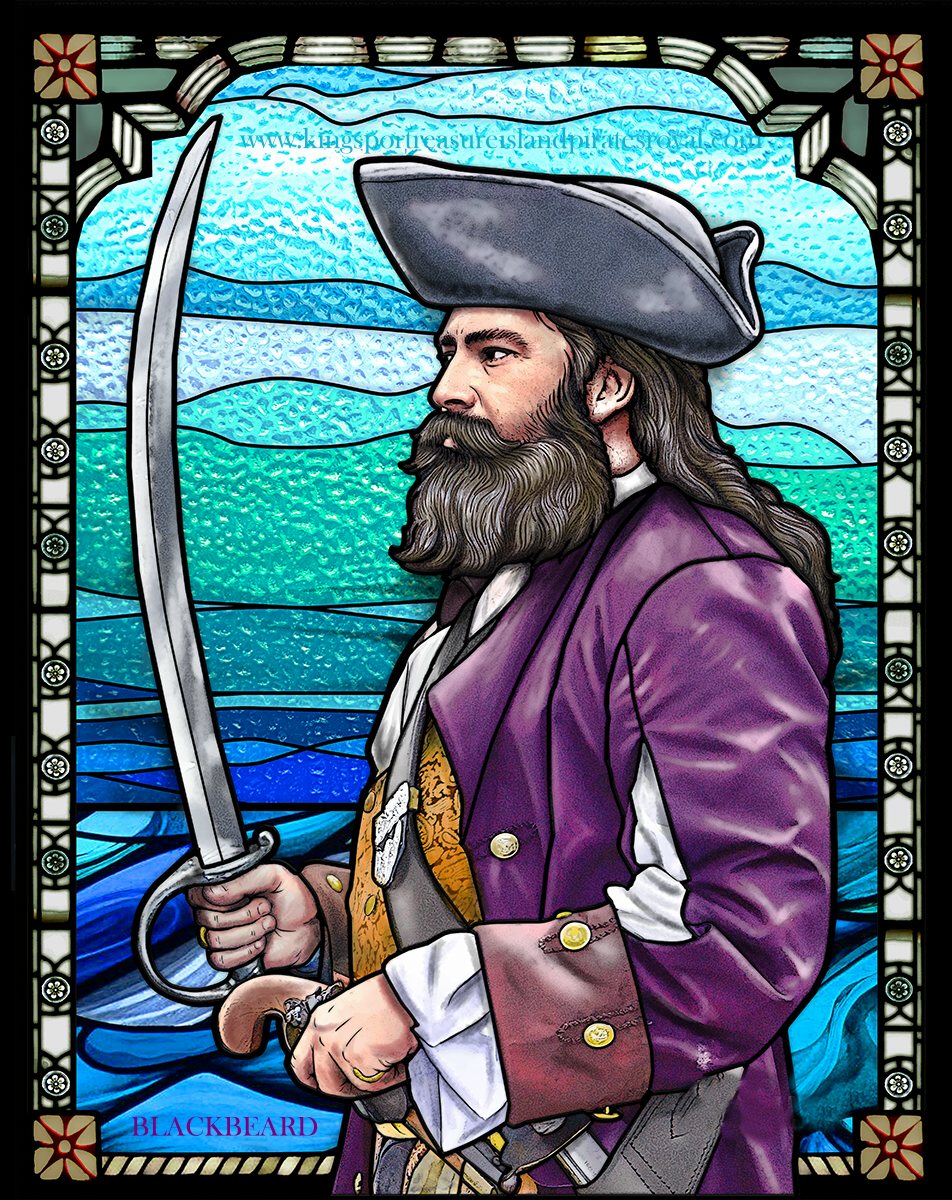
FREEMASONRY
In 1730 or 1731, Franklin was initiated into the local Masonic lodge. He became a grand master in 1734, indicating his rapid rise to prominence in Pennsylvania. The same year, he edited and published the first Masonic book in the Americas, a reprint of James Anderson's Constitutions of the Free-Masons. He was the secretary of St. John's Lodge in Philadelphia from 1735 to 1738. Franklin remained a Freemason for the rest of his life.
DEFENDING THE AMERICAN CAUSE
One line of argument in Parliament was that Americans should pay a share of the costs of the French and Indian War and therefore taxes should be levied on them. Franklin became the American spokesman in highly publicized testimony in Parliament in 1766. He stated that Americans already contributed heavily to the defense of the Empire. He said local governments had raised, outfitted and paid 25,000 soldiers to fight
France - as many as Britain itself sent - and spent many millions from American treasuries doing so in the French and Indian War alone.
In 1772, Franklin obtained private letters of Thomas Hutchinson and Andrew Oliver, governor and lieutenant governor of the Province of Massachusetts Bay, proving that they had encouraged the Crown to crack down on Bostonians. Franklin sent them to America, where they escalated tensions. The letters were finally leaked to the public in the Boston Gazette in mid-June 1773, causing a political firestorm in Massachusetts and raising significant questions in England. The British began to regard him as the fomenter of serious trouble. Hopes for a peaceful solution ended as he was systematically ridiculed and humiliated by Solicitor-General Alexander Wedderburn, before the Privy Council on January 29, 1774. He returned to Philadelphia in March 1775, and abandoned his accommodationist stance.
In 1773, Franklin published two of his most celebrated pro-American satirical essays: "Rules by Which a Great Empire May Be Reduced to a Small One", and "An Edict by the King of Prussia".
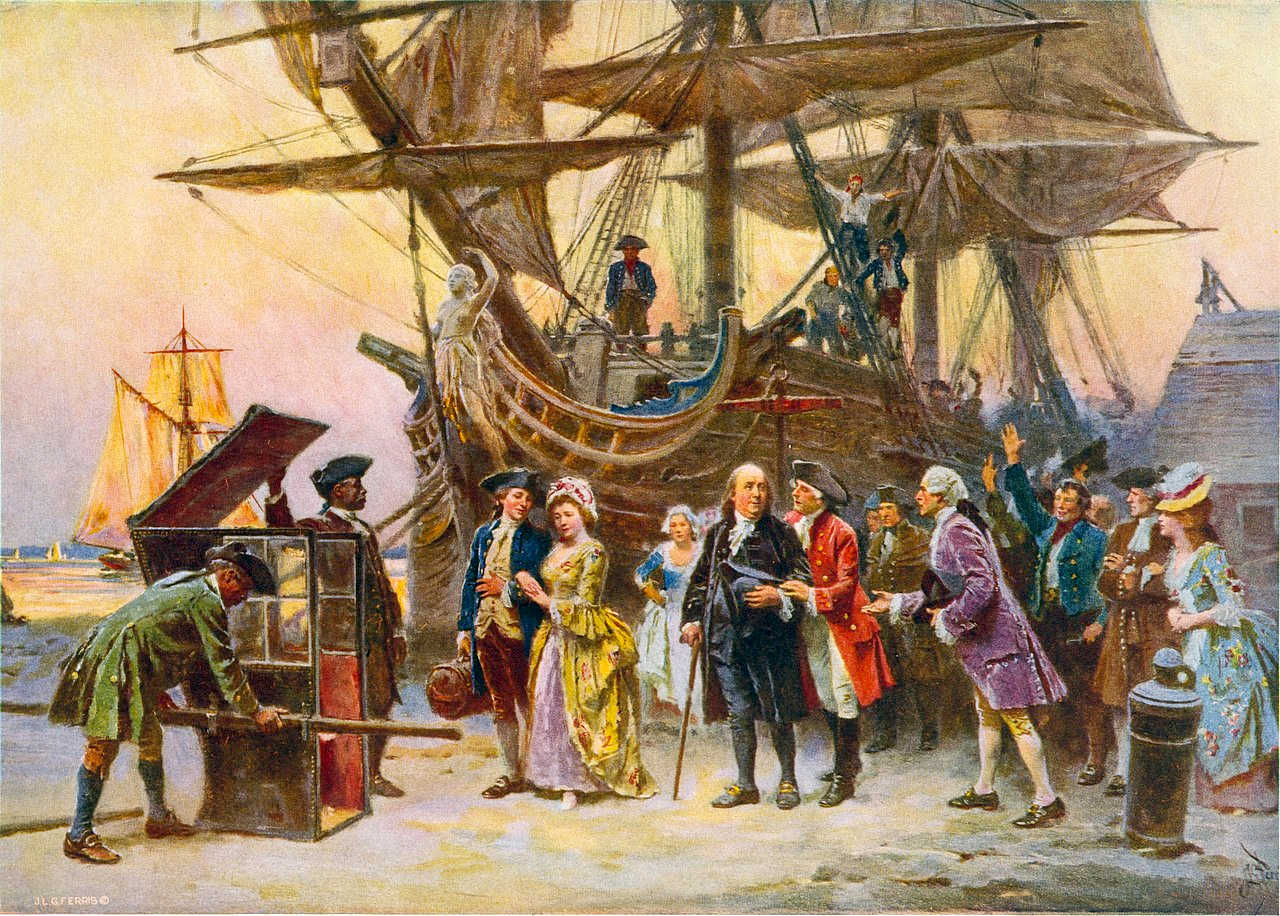
DECLARATION OF INDEPENDENCE
By the time Franklin arrived in Philadelphia on May 5, 1775, after his second mission to Great Britain, the American Revolution had
begun - with skirmishes breaking out between colonials and British at Lexington and Concord. The New England militia had forced the main British army to remain inside Boston. The Pennsylvania Assembly unanimously chose Franklin as their delegate to the Second Continental Congress. In June 1776, he was appointed a member of the Committee of Five that drafted the Declaration of Independence. Although he was temporarily disabled by gout and unable to attend most meetings of the committee, he made several "small but important" changes to the draft sent to him by Thomas Jefferson.
At the signing, he is quoted as having replied to a comment by John Hancock that they must all hang together: "Yes, we must, indeed, all hang together, or most assuredly we shall all hang separately."
INVENTIONS - ELECTRICITY & LIGHTNING
Franklin was a prodigious inventor. Among his many creations were the lightning rod, Franklin stove, bifocal glasses and the flexible urinary catheter. He never patented his inventions; in his autobiography he wrote, "... as we enjoy great advantages from the inventions of others, we should be glad of an opportunity to serve others by any invention of ours; and this we should do freely and generously."
That of course presumes that a person is funded sufficiently to devote their
efforts on a free basis. Whereas, other inventors, such as Thomas
Edison, or Henry Ford. But today, he would be dismayed to learn that big
business effectively controls a monopoly on invention, after the case of
Robert Kearns Vs Ford; being ripped off on the intermittent windscreen
wiper.
Franklin started exploring the phenomenon of electricity in the 1740s, after he met the itinerant lecturer Archibald Spencer who used static electricity in his demonstrations. He proposed that "vitreous" and "resinous" electricity were not different types of "electrical fluid" (as electricity was called then), but the same "fluid" under different pressures. (The same proposal was made independently that same year by William Watson.) He was the first to label them as positive and negative respectively, and he was the first to discover the principle of conservation of charge. In 1748, he constructed a multiple plate capacitor, that he called an "electrical
battery" (not a true battery like Volta's pile) by placing eleven panes of glass sandwiched between lead plates, suspended with silk cords and connected by wires.
In pursuit of more pragmatic uses for electricity, remarking in spring 1749 that he felt "chagrin'd a little" that his experiments had heretofore resulted in "Nothing in this Way of Use to Mankind", he planned a practical demonstration. He proposed a dinner party where a turkey was to be killed via electric shock and roasted on an electrical spit. After having prepared several turkeys this way, he noted that "the birds kill'd in this manner eat uncommonly tender." Franklin recounted that in the process of one of these experiments, he was shocked by a pair of Leyden jars, resulting in numbness in his arms that persisted for one evening, noting "I am Ashamed to have been Guilty of so Notorious a Blunder."
Franklin briefly investigated electrotherapy, including the use of the electric bath. This work led to the field becoming widely known. In recognition of his work with
electricity, he received the Royal Society's Copley Medal in 1753, and in 1756, he became one of the few 18th-century Americans elected a fellow of the Society. The CGS unit of electric charge has been named after him: one franklin (Fr) is equal to one statcoulomb.
Franklin advised Harvard University in its acquisition of new electrical laboratory apparatus after the complete loss of its original collection, in a fire that destroyed the original Harvard Hall in 1764. The collection he assembled later became part of the Harvard Collection of Historical Scientific Instruments, now on public display in its Science Center.
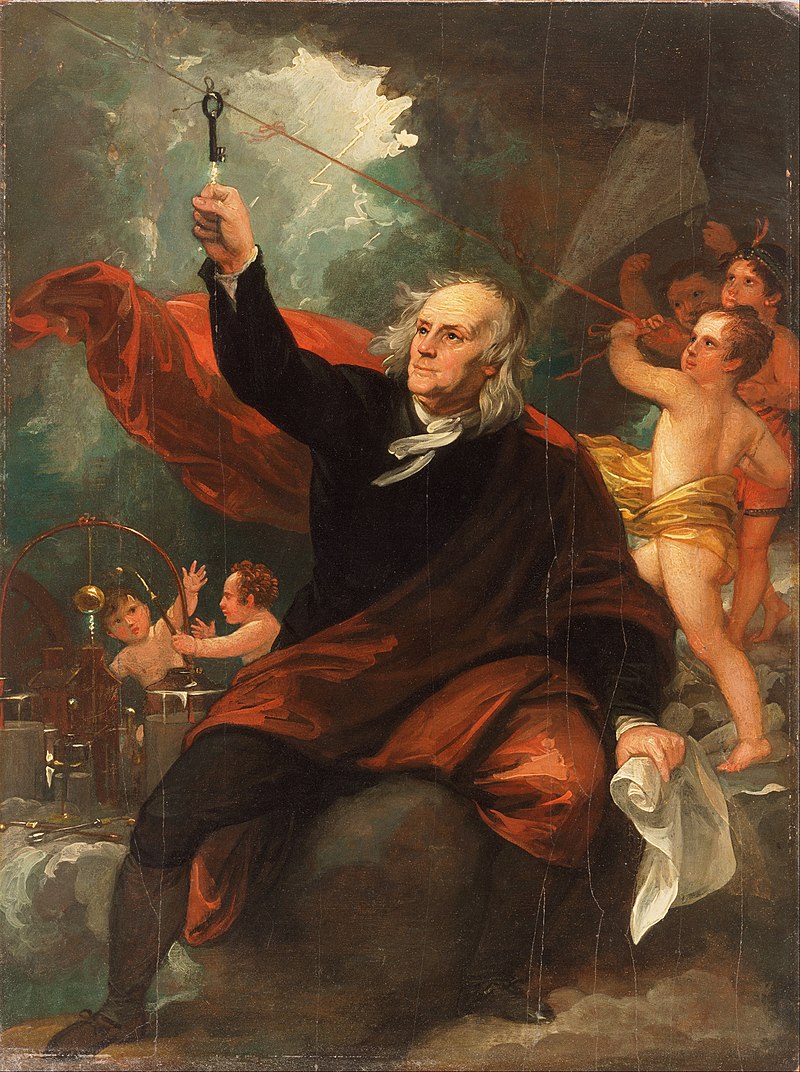
KITE EXPERIMENTS & LIGHTNING ROD
Franklin published a proposal for an experiment to prove that lightning is electricity by flying a kite in a storm. On May 10, 1752, Thomas-François Dalibard of France conducted Franklin's experiment using a 40-foot-tall (12 m) iron rod instead of a kite, and he extracted electrical sparks from a cloud. On June 15, 1752, Franklin may possibly have conducted his well-known kite experiment in Philadelphia, successfully extracting sparks from a cloud. He described the experiment in his newspaper, The Pennsylvania Gazette, on October 19, 1752, without mentioning that he himself had performed it. This account was read to the Royal Society on December 21 and printed as such in the Philosophical Transactions. Joseph Priestley published an account with additional details in his 1767 History and Present Status of Electricity. Franklin was careful to stand on an insulator, keeping dry under a roof to avoid the danger of electric shock. Others, such as Georg Wilhelm Richmann in Russia, were indeed electrocuted in performing lightning experiments during the months immediately following his experiment.
In his writings, Franklin indicates that he was aware of the dangers and offered alternative ways to demonstrate that lightning was electrical, as shown by his use of the concept of electrical ground. He did not perform this experiment in the way that is often pictured in popular literature, flying the kite and waiting to be struck by lightning, as it would have been dangerous. Instead he used the kite to collect some electric charge from a storm cloud, showing that lightning was electrical. On October 19, 1752, in a letter to England with directions for repeating the experiment, he wrote:
When rain has wet the kite twine so that it can conduct the electric fire freely, you will find it streams out plentifully from the key at the approach of your knuckle, and with this key a phial, or Leyden jar, may be charged: and from electric fire thus obtained spirits may be kindled, and all other electric experiments [may be] performed which are usually done by the help of a rubber glass globe or tube; and therefore the sameness of the electrical matter with that of lightening [sic] completely demonstrated.
Franklin's electrical experiments led to his invention of the lightning rod. He said that conductors with a sharp rather than a smooth point could discharge silently and at a far greater distance. He surmised that this could help protect buildings from lightning by attaching "upright Rods of Iron, made sharp as a Needle and gilt to prevent Rusting, and from the Foot of those Rods a Wire down the outside of the Building into the Ground; ... Would not these pointed Rods probably draw the Electrical Fire silently out of a Cloud before it came nigh enough to strike, and thereby secure us from that most sudden and terrible Mischief!" Following a series of experiments on Franklin's own house, lightning rods were installed on the Academy of Philadelphia (later the University of Pennsylvania) and the Pennsylvania State House (later Independence Hall) in 1752.
POPULATION STUDIES
Franklin had a major influence on the emerging science of demography or population studies. In the 1730s and 1740s, he began taking notes on population growth, finding that the American population had the fastest growth rate on Earth. Emphasizing that population growth depended on food supplies, he emphasized the abundance of food and available farmland in America. He calculated that America's population was doubling every 20 years and would surpass that of England in a century. In 1751, he drafted Observations concerning the Increase of Mankind, Peopling of Countries, etc. Four years later, it was anonymously printed in Boston and was quickly reproduced in Britain, where it influenced the economist Adam Smith and later the demographer Thomas Malthus, who credited Franklin for discovering a rule of
population
growth. Franklin's predictions how British mercantilism was unsustainable alarmed British leaders who did not want to be surpassed by the colonies, so they became more willing to impose restrictions on the colonial economy.
Kammen (1990) and Drake (2011) say Franklin's Observations concerning the Increase of Mankind (1755) stands alongside Ezra Stiles' "Discourse on Christian Union" (1760) as the leading works of 18th-century Anglo-American demography; Drake credits Franklin's "wide readership and prophetic insight". Franklin was also a pioneer in the study of slave demography, as shown in his 1755 essay. In his capacity as a farmer, he wrote at least one critique about the negative consequences of price controls, trade restrictions, and subsidy of the poor. This is succinctly preserved in his letter to the London Chronicle published November 29, 1766, titled "On the Price of Corn, and Management of the poor".
OCEANOGRAPHY
As deputy postmaster, Franklin became interested in North Atlantic Ocean circulation patterns. While in England in 1768, he heard a complaint from the Colonial Board of Customs: Why did it take British packet ships carrying mail several weeks longer to reach New York than it took an average merchant ship to reach Newport, Rhode Island? The merchantmen had a longer and more complex voyage because they left from London, while the packets left from Falmouth in Cornwall. Franklin put the question to his cousin Timothy Folger, a Nantucket whaler captain, who told him that merchant ships routinely avoided a strong eastbound mid-ocean current. The mail packet captains sailed dead into it, thus fighting an adverse current of 3 miles per hour (5 km/h). Franklin worked with Folger and other experienced ship captains, learning enough to chart the current and name it the Gulf Stream, by which it is still known today.
Franklin published his Gulf Stream chart in 1770 in England, where it was ignored. Subsequent versions were printed in France in 1778 and the U.S. in 1786. The British original edition of the chart had been so thoroughly ignored that everyone assumed it was lost forever until Phil Richardson, a Woods Hole oceanographer and Gulf Stream expert, discovered it in the Bibliothèque Nationale in Paris in 1980. This find received front-page coverage in The New York Times. It took many years for British sea captains to adopt Franklin's advice on navigating the current; once they did, they were able to trim two weeks from their sailing time. In 1853, the oceanographer and cartographer Matthew Fontaine Maury noted that while Franklin charted and codified the Gulf Stream, he did not discover it:
Though it was Dr. Franklin and Captain Tim Folger, who first turned the Gulf Stream to nautical account, the discovery that there was a Gulf Stream cannot be said to belong to either of them, for its existence was known to Peter Martyr d'Anghiera, and to Sir Humphrey Gilbert, in the 16th century.
An aging Franklin accumulated all his oceanographic findings in Maritime Observations, published by the Philosophical Society's transactions in 1786. It contained ideas for sea anchors, catamaran hulls,
watertight
compartments, shipboard lightning rods and a soup bowl designed to stay stable in stormy weather.
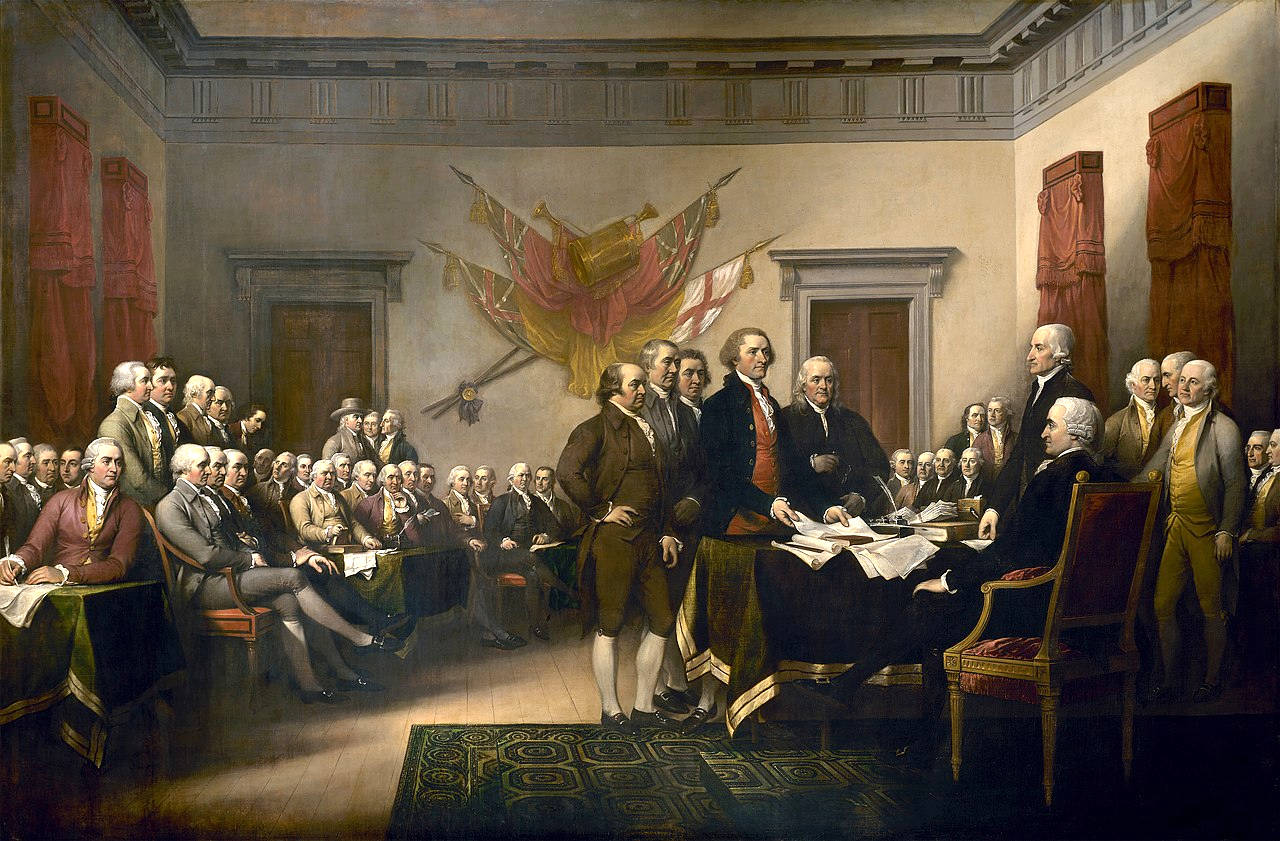
THEORIES AND EXPERIMENTS
Franklin was, along with his contemporary Leonhard Euler, the only major scientist who supported Christiaan Huygens's wave theory of light, which was basically ignored by the rest of the scientific community. In the 18th century,
Isaac
Newton's corpuscular theory was held to be true; it took Thomas Young's well-known slit experiment in 1803 to persuade most scientists to believe Huygens's theory.
On October 21, 1743, according to the popular myth, a storm moving from the southwest denied Franklin the opportunity of witnessing a lunar eclipse. He was said to have noted that the prevailing winds were actually from the northeast, contrary to what he had expected. In correspondence with his brother, he learned that the same storm had not reached Boston until after the eclipse, despite the fact that Boston is to the northeast of Philadelphia. He deduced that storms do not always travel in the direction of the prevailing wind, a concept that greatly influenced meteorology. After the Icelandic volcanic eruption of Laki in 1783, and the subsequent harsh European winter of 1784, Franklin made observations on the causal nature of these two seemingly separate events. He wrote about them in a lecture series.
Though Franklin is famously associated with kites from his lightning experiments, he has also been noted by many for using kites to pull humans and ships across waterways. George Pocock in the book A Treatise on The Aeropleustic Art, or Navigation in the Air, by means of Kites, or Buoyant Sails noted being inspired by Benjamin Franklin's traction of his body by kite power across a waterway.
Franklin noted a principle of refrigeration by observing that on a very hot day, he stayed cooler in a wet shirt in a breeze than he did in a dry one. To understand this phenomenon more clearly, he conducted experiments. In 1758 on a warm day in Cambridge, England, he and fellow scientist John Hadley experimented by continually wetting the ball of a mercury thermometer with ether and using bellows to evaporate the ether. With each subsequent evaporation, the thermometer read a lower temperature, eventually reaching 7 °F (−14 °C). Another thermometer showed that the room temperature was constant at 65 °F (18 °C). In his letter Cooling by Evaporation, Franklin noted that, "One may see the possibility of freezing a man to death on a warm summer's day."
According to Michael Faraday, Franklin's experiments on the non-conduction of ice are worth mentioning, although the law of the general effect of liquefaction on electrolytes is not attributed to Franklin. However, as reported in 1836 by Franklin's great-grandson Prof. Alexander Dallas Bache of the University of Pennsylvania, the law of the effect of heat on the conduction of bodies otherwise non-conductors, for example, glass, could be attributed to Franklin. Franklin wrote, "... A certain quantity of heat will make some bodies good conductors, that will not otherwise conduct ..." and again, "... And water, though naturally a good conductor, will not conduct well when frozen into ice."
While traveling on a ship, Franklin had observed that the wake of a ship was diminished when the cooks scuttled their greasy water. He studied the effects on a large pond in Clapham Common, London. "I fetched out a cruet of oil and dropt a little of it on the water ... though not more than a teaspoon full, produced an instant calm over a space of several yards square." He later used the trick to "calm the waters" by carrying "a little oil in the hollow joint of my cane".
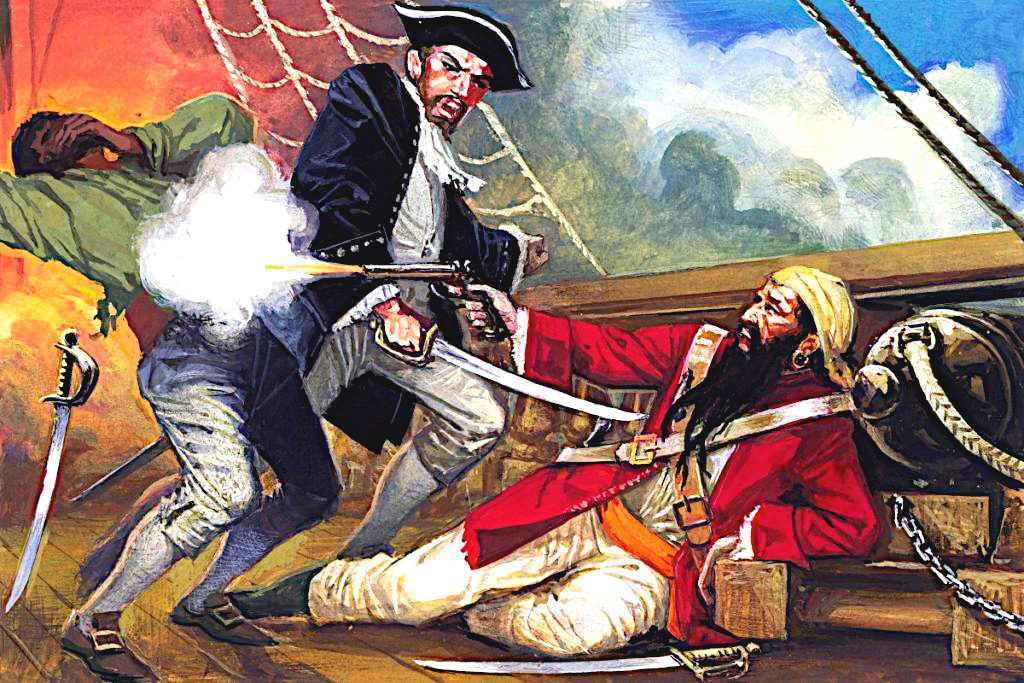
Aboard
the Adventure in 1718, Lieutenant Robert Maynard shoots and kills Blackbeard
It
is said that "Dead Men Tell No Tales." For the most part that is
true, but some men leave clues as to their exploits when they are alive. And
those clues are tales from a dead man. Two such people are Captain
Henry Morgan and Edward
Teach, otherwise known as Blackbeard.
|






